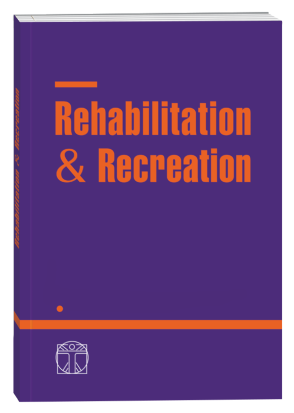THE IMPACT OF PHYSICAL THERAPY ON THE CONDITION OF PATIENTS WITH COVID-19 DURING LONG-TERM REHABILITATION
DOI:
https://doi.org/10.32782/2522-1795.2023.17.9Keywords:
physical therapy, COVID-19, rehabilitation, quality of life, endurance.Abstract
To evaluate the impact of physical therapy on the quality of life and cardiorespiratory endurance of COVID-19 patients during long-term rehabilitation. The study involved 60 patients (average age 59(8.3) years) who were hospitalized due to COVID-19. Patients were randomly assigned to two groups, with 30 individuals in each: the intervention group and the control group. The intervention group received a physical therapy program, which included exercises to improve lower limb strength, activities to restore physical endurance, stretching exercises for trunk, chest, and upper limb muscles, exercises aimed at enhancing respiratory muscle strength, controlled breathing, and airway clearance during the first 6 weeks post-discharge. All patients underwent surveys, anthropometry, assessments of quality of life using the SF-36 questionnaire, and cardiorespiratory endurance using the 6-minute walk test. A positive impact of the physical rehabilitation course was observed after 6 weeks concerning the quality of life indicators: physical functioning (57(17.3) vs. 46.8 (14.8)), vitality (56.7(9.2) vs. 47.7(7.7)), and general health status (55.3(7.1) vs. 49(4.9)), respectively (p < 0.05). The statistically significant difference between the intervention and control groups persisted at 12 months for vitality (61.5(7.4) vs. 57.3(6.8)) and mental health (59.7(9.4) vs. 54.1(8.5)), respectively (p < 0.05). The 6-minute walk test values were significantly higher in the intervention group immediately after 6 weeks of rehabilitation (413(76.8) m vs. 342.8(73.0) m, respectively; p < 0.05). This statistically significant difference between the groups persisted over the course of the year. The application of physical therapy for COVID-19 patients during the first 6 weeks post-discharge positively influences their quality of life, specifically enhancing physical functioning, mental health, and vitality, and this improvement is maintained up to 12 months compared to patients who did not receive physical therapy. Patients who underwent physical therapy also demonstrated higher cardiorespiratory endurance from the 6th week onwards, and this improvement was sustained throughout the year.
References
Антомонов М.Ю., Коробейніков Г.В., Хмельницька І.В., Харковлюк-Балакіна Н.В. Математичні методи оброблення та моделювання результатів експериментальних досліджень: навчальний посібник. К. : «Олімпійська література», 2021. 216 с.
Anka, A.U., Tahir, M.I., Abubakar, S.D., Alsabbagh, M., Zian, Z., Hamedifar, H., et al. (2021). Coronavirus disease 2019 (COVID-19): An overview of the immunopathology, serological diagnosis and management. Scandina-vian journal of immunology, 93(4), e12998. DOI:10.1111/sji.12998
Arnold, D.T., Hamilton, F.W., Milne, A., Morley, A.J., Viner, J., Attwood, M. et al. (2021). Patient outcomes after hospitalisation with COVID-19 and implications for follow-up: results from a prospective UK cohort. Thorax, 76(4), 399–401. https://doi.org/10.1136/thoraxjnl-2020-216086
Halpin, S. J., McIvor, C., Whyatt, G., Adams, A., Harvey, O., McLean, L. et al. (2021). Postdischarge symptoms and rehabilitation needs in survivors of COVID-19 infection: A cross-sectional evaluation. Journal of medical virology, 93(2), 1013–1022. https://doi.org/10.1002/jmv.26368
Li, J., Xia, W., Zhan, C., Liu, S., Yin, Z., Wang, J. et al. (2022). A telerehabilitation programme in post-discharge COVID-19 patients (TERECO): a randomised controlled trial. Thorax, 77(7), 697–706. https://doi.org/10.1136/thoraxjnl-2021-217382
Liu, K., Zhang, W., Yang, Y., Zhang, J., Li, Y., & Chen, Y. (2020). Respiratory rehabilitation in elderly patients with COVID-19: A randomized controlled study. Complementary therapies in clinical practice, 39, 101166. https://doi.org/10.1016/j.ctcp.2020.101166
Nopp, S., Moik, F., Klok, F. A., Gattinger, D., Petrovic, M., Vonbank, K. et al. (2022). Outpatient Pulmonary Rehabilitation in Patients with Long COVID Improves Exercise Capacity, Functional Status, Dyspnea, Fatigue, and Quality of Life. Respiration; international review of thoracic diseases, 101(6), 593–601. https://doi.org/10.1159/000522118
Poudel, A.N., Zhu, S., Cooper, N., Roderick, P., Alwan, N., Tarrant, C. et al. (2021). Impact of Covid-19 on health-related quality of life of patients: A structured review. PloS one, 16(10), e0259164. https://doi.org/10.1371/journal.pone.0259164
Singh, S.J., Puhan, M.A., Andrianopoulos, V., Hernandes, N.A., Mitchell, K.E., Hill, C.J., et al. (2014). An official systematic review of the
European Respiratory Society/American Thoracic Society: measurement properties of field walking tests in chronic respiratory disease. The
European respiratory journal, 44(6), 1447–1478. DOI:10.1183/09031936.00150414
Soh, S.E., Morello, R., Ayton, D., Ahern, S., Scarborough, R., Zammit, C. et al. (2021). Measurement properties of the 12-item Short Form Health Survey version 2 in Austral-ians with lung cancer: a Rasch analysis. Health and quality of life outcomes, 19(1), 157. https://doi.org/10.1186/s12955-021-01794-w
Szarvas, Z., Fekete, M., Horvath, R., Shimizu, M., Tsuhiya, F., Choi, H.E. et al. (2023). Cardiopulmonary rehabilitation programme improves physical health and quality of life in post-COVID syndrome. Annals of palliative medicine, 12(3), 548–560. https://doi.org/10.21037/apm-22-1143
Tallarico, R.T., Deniau, B., Fong, N., Ghosn, J., Legrand, M., & French-COVID and the FROG-ICU Investigators (2022). Differences in HADS and SF-36 scores 1 year after critical illness in COVID-19 patients. Intensive care medicine, 48(9), 1245–1247. https://doi.org/10.1007/s00134-022-06797-9
Downloads
Published
How to Cite
Issue
Section
License

This work is licensed under a Creative Commons Attribution-NonCommercial-NoDerivatives 4.0 International License.











